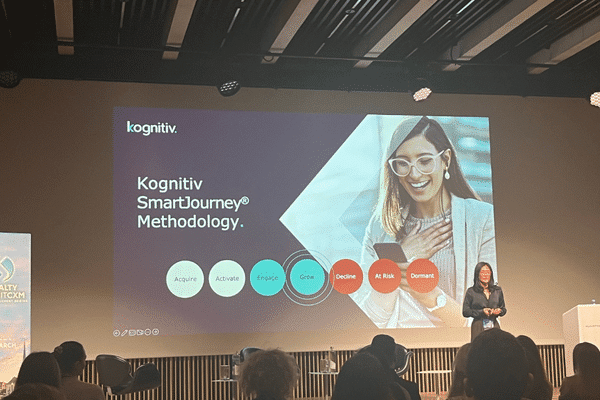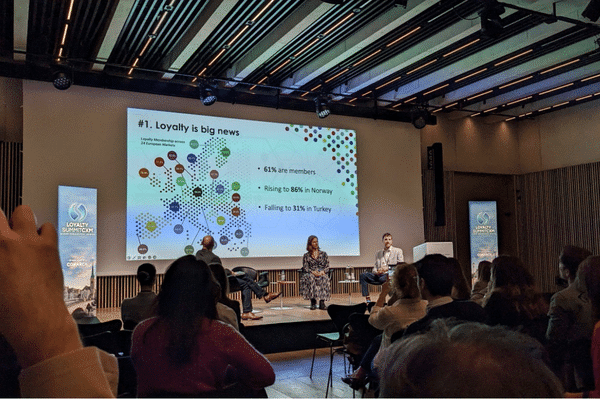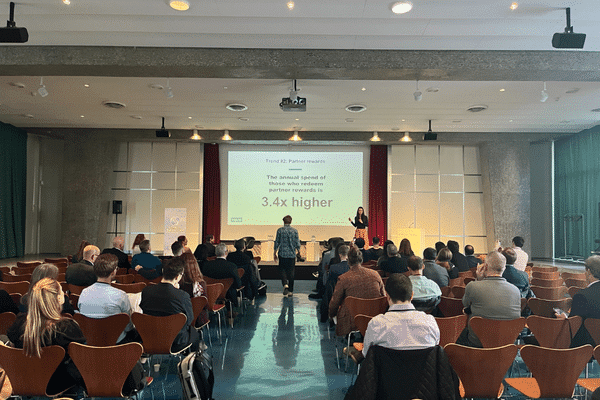After so many years of digital conferences, virtual meet and greets and meetings that inevitably start with someone being on mute or stuck in a waiting room, it was a delight to attend the first European Loyalty Summit CXM in Zurich this month. Co-chaired by Phil Rubin, Iain Pringle, Mike Atkin and David Slavick the conference promised a packed agenda of insight, case studies and inspiration. It didn’t disappoint.
Michael Killeen of The CX Academy was the first external speaker and spoke passionately about what the loyalty industry can learn from the CX industry. In line with popular loyalty thinking he extolled the importance of the emotional over the functional “Customer experience is how customers FEEL about all of the interactions they have with your company.” He shared his view that it is actually your staff who are the king, not your customer “Happy Staff = Happy Customer = Happy C-Suite” and then went on to introduce a CX framework of 6 emotional drivers to help brands build real bonds with their customers:
- I Trust You – You build trust in everything you do with me
- You Know Me – you treat me like an individual and understands my needs
- You Make it Easy – you make it easy for me to do business with you
- You Get Me – you genuinely understand what it’s like to be in my shoes
- You Deliver On Your Promise – you manage, meet and exceed my expectations
- You Fix Things – When things go wrong you fix them heroically
Whilst the framework was designed to work for CX, the principles clearly apply to the loyalty industry.
Next came Jisun Hahn, the EVP and Chief Strategy Officer for Kognitiv who talked about new ways to approach the customer life cycle. She introduced the Kognitiv SmartJourneyTM methodology – a behavioural customer segmentation that they’ve worked on with over 60 clients:

Kognitiv’s recommendation is for programmes to focus on the “Engage” and ”Grow” segments, rather than “Decline” and “At Risk” segments, where it is far more challenging to increase value. By mapping out the most valuable movements and targeting these priority segments, clients of Kognitiv’s have achieved a 182% growth in margin (as they reduced spend by focusing on a specific cohort), a 44% increase on spend on members over non-members and a 29% increase on redemption spend.
Cristina Zilliani of the Loyalty Observatory (https://www.osservatoriofedelta.unipr.it) then talked about the evolution of loyalty programmes – past, present and future. A particular highlight of the speech which was packed with great insight and case studies was her point of view that loyalty marketing is progressing to the next stage of sophistication - as programmes address bigger concerns such as helping other people and the planet. She called this next phase of loyalty the “Citizen Engagement Management.”
Charlie Hills of Mando-Connect and Nick Fishbourne of YouGov then shared the brand new “Understanding Loyalty in Europe” research, which maps, for the very first time, loyalty membership, appeal and impact across 24 European markets. On average, across those markets, 61% are members of loyalty programmes, 56% find them appealing and 43% stay more loyal as a consequence of membership. But whilst the averages are interesting it was the market specific insight and case studies that really brought the data to life. It was fascinating to learn that the Brits are the biggest fans of loyalty of all the European markets, that Norway and Sweden see the highest membership and that the Danish are the most sceptical. Lots of interesting debate and discussion about why that might be the case and what programmes can do to action these very valuable insights.

Through-out the conference a big theme that emerged is the power of partnerships to achieve more in loyalty. It was covered in keynotes, in case studies and in panels. David Slavick of Ascendant Loyalty hosted a particularly interesting panel on the subject towards the end of day one. That panel all agreed that partnerships are a very effective tool for programmes to acquire new customers, but also to engage new ones. And they talked openly about the opportunities of partnerships (new ideas, new resources, new products and services) and also the challenges (more stakeholders, the need for clear objectives and clear measurement and how complex it can become). The theme continued into Antavo’s presentation on Day Two where the conversation moved onto the impact of partners – noted as Trend 2 in Antavo’s presentation. In their data they see that loyalty members who engage with partner rewards are 3.4 time more valuable than those that don’t.

A fascinating conversation then followed with adiclub about the future of loyalty, the importance of customer engagement and the brand’s big ambition to have 500m members!
Samsung Members was then showcased by Laura Moore and Cathryn Lodwidge of the European Samsung team. They shared how Samsung is using the powerful combination of technology and customer passions to drive maximum customer engagement with the brand. So far, the programme has over 60m members across Europe and its mission is to help them do more of the things they love across the key passions of photography, entertainment, wellbeing, home and life hacks. The key programme pillars are fourfold:
- We support
- We inspire
- We reward
- We connect

It’s proving to be a highly effective model and really powered performance – members now stay more, buy more and engage more across multiple performance metrics.
Bradley Breuer then came on to share the Petsmart Treats story, a powerful US programme for the almost 70% of American households with pets (95% of whom think see their pets as part of their family). With 60m members the programme sets out to give pet parents “an experience so compelling, emotional and easy that the brand earns lifelong loyalty”. It makes 5 big commitments:
- Treats members always get more
- It’s easy to use and easy to understand
- It’s free to join, with great benefits, starting on day one
- Loyalty is rewarded and pet parents earn more as the relationship grows
- It’s one more way we deliver on our brand promise: anything for pets
And activates the programme through multiple channels. Key to its success has been the development of personalised user journeys and identification of the key moments and touchpoints, brilliant partnerships (e.g., with Mixbook – a personalised photobook), promotions (such as big Superbowl activations) and strong rewards and offers.
After the case studies, came more industry experts. Pamela Erlichmann of Jebbit introduced the concept of conversational commerce in loyalty marketing. By asking members questions and quizzes Jebbit have unlocked a powerful and engaging new insight tool for loyalty marketers. They have identified the 6 most effective types of questioning value exchange – 83% of people who engage complete the quizzes:
- Save me time
- Give me a recommendation
- Entertain me
- Test my knowledge
- Teach me something
- Unlock a benefit for me
It was a thought-provoking approach as to how loyalty programmes can use quizzes to build engagement with members, but also create invaluable insight too.
There followed some fascinating discussions, panels and presentations on the future of the industry and the power of technology – do people want NFTs? Will loyalty enter the metaverse? Will people trade their data for points? (according to data presented by Comarch 92% will). What implications does GDPR have for loyalty programmes and where do the boundaries and opportunities lie? How can you create a crystal ball for customer behaviour (Kognitiv have)? What is Web3 and what opportunities does it bring? The importance of zero party data (that which a customer intentionally and proactively shares with a brand) was undisputed across all discussions.
There was also a great panel on brand trust, loyalty and stakeholder capitalism where experts from Antavo, REI and Quiksilver/Roxy/Billabong talked about the importance of loyalty beyond purchase – revisiting the theme from the Loyalty Observatory talk from earlier in the agenda. Rewarding for engagement and sustainable behaviours is here to stay – 66% of companies have or will have rewards for sustainable behaviours in the next 3 years. It’s a trend which is here to stay.
The ultimate highlight of the conference was the keynote presentation from Rory Sutherland who opened by talking about the importance of creating fabulous moments in loyalty marketing “the logical answer is fine, it’s OK but it’s not magical”. He talked about a loyalty programme as being like corrective eye surgery for marketing, how you cut the data and the perspective you take on it is what matters. It’s very importance that we focus on the emotional not just the rational moments. To create the magical, you need to understand the why as well as the what, and behavioural science is the best way to understand the why.
He then proposed some actions for loyalty marketers everywhere:
- Look at the longitudinal view – what’s happening in the long term?
- Look at the anomalies – what are the weird things that are happening and have happened? These will give you the insight for the breakthrough ideas.
- Dare to be trivial – “test stupid small things” – these could make a huge difference.
He talked about the importance of creating a brilliant value exchange for people – loyalty programmes and loyalty currencies are already a great value exchange – people often value points more than money. People can value an experience over money too – he shared a brilliant case study from the restaurant brand Dishoom. If people paid before 6pm they rolled some dice – if they got a 6, they got the meal for free – how much more rewarding than a 16.6% discount for everyone! And it had the added benefits that people spent more on their meals (on the chance they were going to get it for free), and it brought talkability and excitement to the occasion as well.

In maths 3 x 1 = 1 x 3
In psychology it doesn’t. “It's very easy to look at the “what” and get completely the wrong “why”.
He went on to talk about how cost is feeling not a number. And that loyalty is ideally placed to bring more value to the customer experience. There are countless examples in loyalty marketing: from Amazon Prime (paying once up front so it feels less), to Selfridges (free postage made people buy more often), to tier points (business travellers will actually fly more often to avoid being bumped down a tier), to digital check ins for extremely loyal hotel customers (the time saved means a lot more to a frequent visitor than an infrequent one).
He then concluded by challenging loyalty marketers to see where they can apply the real value of loyalty – which is actually outside of the programme! “3 or 4 times a year you should be trying to come up with something amazing that can be applied elsewhere”. He proposed that loyalty marketers worry less about pre-rationalised testing. Try draft things, try things that once you have tested them you can never go back. Test things that are about real human needs – like status, certainty, autonomy, relatedness and fairness. Test more!
It was a truly brilliant conference and one we highly recommend attending in future years – great insight, great data, great conversation, great networking, great people and, of course, as it was hosted in Switzerland – great cheese!
Written and contributed by Charlie Hills CLMP™, Managing Director & Head of Strategy at Mando-Connect.




